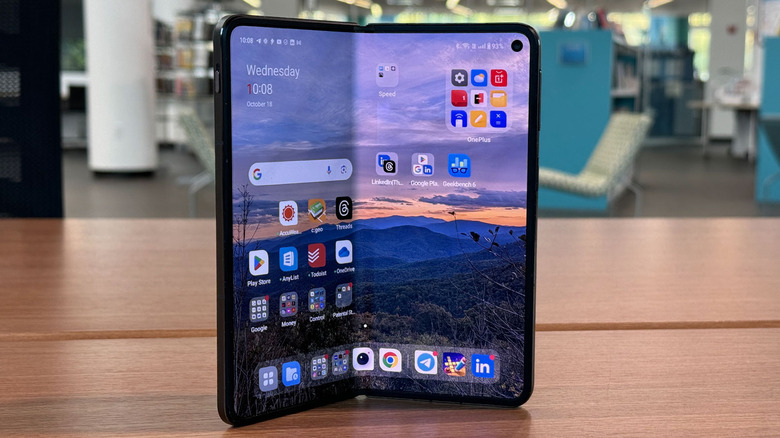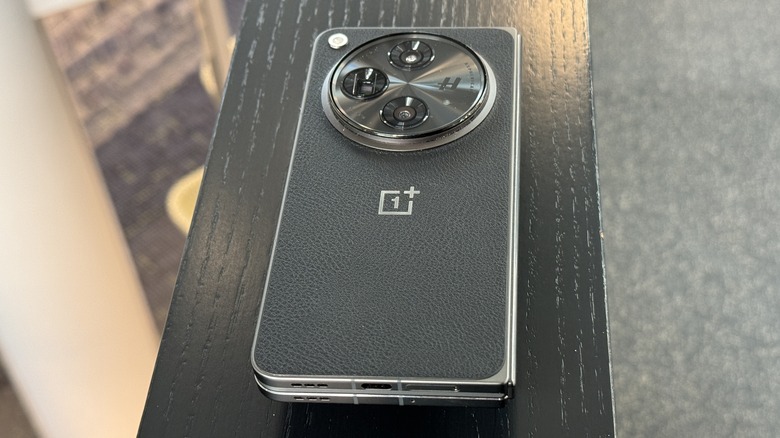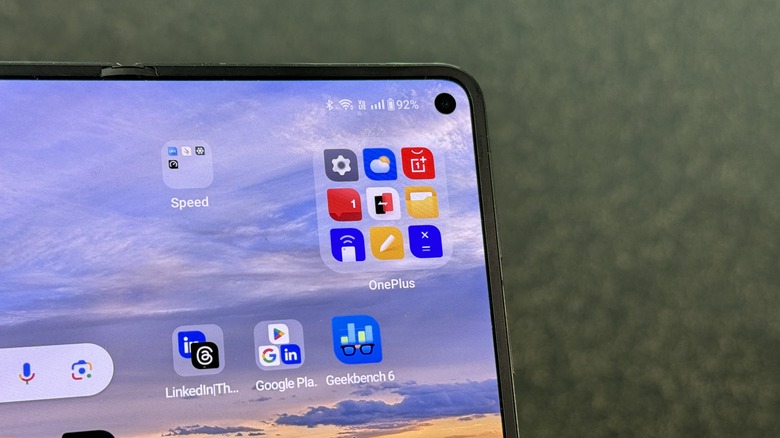OnePlus Open Review: The Highest-End Foldable Yet
- Great cameras
- Awesome build quality
- Amazing software
- Solid performance
- Fast charging
- No wireless charging
- Night time video performance is not great
We may receive a commission on purchases made from links.
Something remarkable is happening in the United States phone ecosystem. Once dominated by a single player, foldables have launched in the United States in a major way from the likes of Google, Motorola, and Samsung. In the space of the last four months, two companies not named Samsung have launched three foldables in a market that previously only had two total. That's a 150% improvement, for those keeping score. This week, we saw two more.
Yesterday, we got a sub-$600 foldable in the Motorola Razr (though that's only an introductory offer) in the United States. Now, to make matters worse for Samsung (but so, so much better for literally everyone else) we have the OnePlus Open, and this is a phone that you need to pay attention to.
The OnePlus Open is an unexpectedly capable phone that arguably delivers the best of both worlds: the inner screen of the Samsung Galaxy Z Fold 5, and the cover screen usability of the Google Pixel Fold. Meanwhile, it does so tipping the scales at only 239 grams (just 5 grams more than the Galaxy S23 Ultra). In terms of thickness, it measures just 2mm thicker than that same phone, but there is a major caveat — stay tuned for that.
But all told, OnePlus built one heck of a phone, right out of the gate, and it comes priced competitively as well. OnePlus provided a OnePlus Open device for the purposes of this review. The phone is still on pre-production software as of this writing.
Great hardware
The headline for this phone is in the hardware, which is ridiculously thin and light, though not as thin as the Honor V2. The OnePlus Open has what today's magazines would describe as a "healthy weight": It's thin, but not ridiculously so. That's a great combination, but there is one other important consideration. Yes, this phone is 11.9mm thick, but the palatial camera bump on the back is so big it comes with its own government. It adds another 5.2 mm which, much as is the case with the Honor V2, basically adds another third to the thickness.
The phone is powered by a Snapdragon 8 Gen 2 processor, 16 GB of RAM, and 512 GB of storage. All of those are baller specifications in 2023 which more than justify the price point. The battery clocks in at 4,805 mAh, and supports up to 67W charging from the charging brick that is included in the box.
The hardware has a hinge similar to that used in the Oppo Find N3 but with a reduced number of components. Like the Oppo Find N3, the crease on this phone is barely noticeable. Speaking of the hinge, according to OnePlus, this phone can handle up to one million opens and closes, which is a staggering number. For reference, the Samsung Galaxy Z Fold 5 can handle up to 200,000 folds.
One thing missing
If there is one flaw in the hardware, it's that this phone does not have wireless charging. If you were to describe OnePlus's relationship with wireless charging on Facebook, you'd probably have to select the "It's complicated" box, since as recently as the OnePlus 10 (just under two years ago) OnePlus flagships supported the feature. If you go a little further back in time, OnePlus phones had up to 50W of wireless charging, a figure which is still better than rival smartphones released in 2023 can boast.
These days, OnePlus is doubling down on fast wired charging — which, by the way, is indeed really fast and really cool — but it has seemingly abandoned wireless charging in an effort to keep to its "fast and smooth" mission statement. Wireless charging is not fast; we get it. But once again, when a customer is shelling out this much money for a device, maybe it's better if OnePlus lets them decide how they want to charge it.
Minimal Crease, Maximum Gain
The displays on this phone are stellar. Both panels are capable of 120 Hz refresh rates, with the inside screen capable of ramping down to 1 Hz while the outside screen can get to as slow a refresh as 10 Hz. The inside display is nearly square and has a 2K resolution. The outside screen is a 6.3-inch panel with a 20:9 aspect ratio that is a delight to use. Both panels are capable of a slightly ridiculous 2,800 nits of peak brightness.
When the phone is closed, it acts and feels like a normal slab phone. The 6.3-inch display is a great size for one-handed usability. Inside, the display is equally great, but the phone doesn't open to a full 180 degrees. It's close to 178 degrees or so, which isn't bad and you quickly get used to it. Plus the camera bump on the back prevents the phone from sitting flat anyway.
Multitasking monster
The inner screen of the OnePlus Open can have three apps open at one time. Your mind might imagine this as two apps running side-by-side with a third floating window. That has quickly become the standard on inner screen multitasking, but OnePlus goes beyond that. The Open allows you to run three full-sized apps on the inner screen.
After you open your first app, you can tap and hold another app in the taskbar and then drag that over to one side or the other of the screen. That new app will open up next to the first, side by side. You can also tap and hold a third app and drag that one to the lower half of the screen. When you do that, that third app will open in the full screen below your first two apps, which pushes the top two apps about 90% of the way off the top of the screen. You can still see the bottom of those apps, and if you tap there, you will push the bottom app 90% off the bottom of the screen, restoring the original two apps, with just the top of the third app visible.
Now, you can tap an indicator at the top of either of those two apps and choose Expand, to get two full-sized apps and one smaller-sized app. It's also possible to expand that third app, so what you're left with are three full-sized apps all running at the same time, and all switchable between each other just by tapping on the 10% of the window you can see.
Three apps, no problem
Put simply, this is utterly brilliant. OnePlus has pushed the boundary on the inner screen to bring full functionality to all three apps you're multitasking with. It's intuitive and quick to use; once you build this into your workflow, you will not want to go back.
Alternatively, you can stack three side-by-side apps next to each other if you prefer that user interface, and similarly, tapping on either side will bring the focus to those apps when you want them. Plus, you can save these app groups to your home screen to open them all later with a single tap.
The inner screen also has a taskbar running across the bottom of the screen with a dock where you can launch apps. The dock will sometimes interfere with the bottom UI of an app (such as a chat window where you would type your responses). In cases like this, you can tap and hold on the bottom of the screen to the left or right of the taskbar to make it disappear. That's not the most intuitive gesture, and frankly, it would make more sense for OnePlus to just shrink the apps a bit so there's room for the taskbar under them, but this multitasking system is so great, that you'll give it a pass.
Hello Color OS
OnePlus has also embraced ColorOS, for better or for worse. One noticeable oddity about the software is the inability to change your home screen's app layout to anything other than a 6 x 4 grid. It's very iOS-like and it's not the worst thing in the world, but when you have a lovely wide screen to work with (for a cover screen), you should be able to go with a five-column grid.
One neat thing about ColorOS is how it handles folders. First of all, all you need to do is pinch two fingers together and you can select multiple apps and tap "Create folder" to drop them all into their own folder. If your workflow loves folders, you'll love this UI.
Similar to the Nothing Phone 2, you can "expand" folders from a 1x1 icon to a 2x2 grid which displays 3x3 apps. Each of those apps is selectable, so you can open them, plus you can swipe inside the folder to move between pages. This gives you a lot of apps that you can access quickly, and it seems only a matter of time before Android officially adopts this mechanism.
You also get other small software tweaks like being able to change the shape or theme of your icons, change your page transitions, and do a lot of the nerdy customization stuff that OnePlus is famous for these days.
Camera caveats
That brings us to the cameras, and this is arguably the best camera set you can find on a foldable, but it can be a bit punchy under some circumstances as well. It should also be mentioned that the bulk of our camera tests occurred before one final software update prior to its announcement; a software update that included some camera fixes. That being said, we didn't find any show-stoppers with the camera that would prevent us from drawing some conclusions.
You'll be happy to know that the impressively-sized camera bump comes by its size honestly, with three fairly large sensors. The main camera is a 48-megapixel sensor with an f/1.7 aperture; the ultrawide lens is also a 48-megapixel camera with f/2.2 aperture and 114-degree field of view; and the telephoto camera is a 64-megapixel sensor with an f/2.6 aperture and 3x optical zoom, along with a 6x in-sensor crop. There are also two front-facing cameras at 32 megapixels and 20 megapixels respectively.
Hit the lights
When lighting is great, photos and video are both excellent. You get the same color consistency between camera lenses that you expect to see on a flagship phone. There are multiple levels of zoom on offer: 2x, which is a sensor crop from the main sensor; 3x which is the optical sensor; and 6x which is a sensor crop from the telephoto sensor. Of course, the reason you can do this is because the sensors have such high resolutions: 50MP and 64MP respectively. The size of the periscope lens in particular is attractive because you get that extra 6x punch in that most flagships — even ones that don't fold — simply don't offer. Or, a flagship like the Pixel 8 Pro gives you 5x, but nothing in between that. OnePlus has a good formula here, and it's one that other phone makers should emulate.
Meanwhile, macro mode is one of the best you'll see this year. You get a stark image that retains a ton of detail with excellent bokeh in the background. As for capturing moving subjects, the phone captures well with the main sensor, but less so when you zoom. Aperture and the resulting shutter speed necessities are mostly to blame for the telephoto struggles—physics usually wins those arguments.
Video is also beautiful and smooth, from all three sensors — the main sensor, and both selfie cameras. The inner selfie camera lacks stabilization, but considering the likely use cases such as video conferencing, or using the phone as a tripod, you don't anticipate needing to compensate for motion that much.
In the velvet darkness
At night, this camera continues to hold up, but with a couple of caveats. Good and even great pictures are possible, as long as you take a little extra time to tell your phone what to focus on before you snap the photo. In short, if you whip out the camera and snap a frame, you'll more than likely end up with a slightly overexposed shot with soft focus. It'll still be usable, but it won't be as sharp. Tap on your subject, however, and everything zaps into focus and the exposure gets cranked down for a nice, much more crisp shot. Below is a sort of before (left) and after (right) comparison.
Motion is still tricky, as the light-greedy OnePlus Open tends to linger on the shutter a bit, causing some blur in moving subjects. But otherwise, as long as you take your time, you can get some excellent shots: Just tell your friends to stay still and smile. The surprising part is, that all of this is true regardless of what lens you decide to use. Even shots up to 6x optical can be tight. It's pretty impressive.
Video, on the other hand, is pretty bad when you're walking, but tightens up when you stop. There's still a good amount of grain in the darker areas, but beyond that, stay still and pan, and you can collect some usable footage, and that's probably the most impressive part of this camera overall.
Battery and performance
The OnePlus Open is a battery champion, regularly ending a day with 30-35% left in the tank. That includes days out, away from Wi-Fi. The key is the ability to use the cover screen much more than the inside screen. The 20:9 aspect ratio makes the cover screen feel normal if you're used to a slab phone, so the only time you open the foldable is when you need that full, outsized interface.
Like its OnePlus brethren, the OnePlus Open comes with 67W wired charging, and as mentioned, no wireless charging. That is disappointing, but that also means that you don't necessarily need to charge your phone overnight if you don't want to. Indeed you can get to 50% in around 15 minutes and 100% in less than 45 minutes. Put simply, if you give yourself a few minutes to charge before you head out, you'll likely get enough juice to last until you get home.
When it comes to performance, the Snapdragon 8 Gen 2 processor is no slouch and can keep up with any task (or set of three tasks) you can throw at it. The phone simply flies. It registers a 1,101/4,109 single/multi-core score on Geekbench which is not amazing strictly by the numbers. Gaming on the phone is great though, with titles like "Call of Duty: Mobile" performing admirably.
Other odds and ends
During the review period, Google Pay did not function at all. The phone has NFC coils, but it has not yet passed certification with Google for it to work. OnePlus says this may be resolved by the time the phone reaches retail availability later this month. When it does, we assume it will work normally, but we were unable to test it and it's a little concerning that it's not ready yet and, by all accounts, may not be when the phone ships.
The OnePlus Open comes with OnePlus's signature alert slider which you can use to silence the phone or set it to vibrate. Speaking of which, the haptic engine on this phone is very tight and satisfying.
The power and volume buttons rest high on the phone's right side, which can take some time to get used to. Sometimes the alert slider can be mistaken for one of those buttons when the phone is closed since it's directly opposite them when the phone is open.
The selfie camera on the inside screen is positioned in the upper right corner of the display, as opposed to the more typical center of one of the two halves. This puts the camera more out of the way than normal, but it also unfortunately places the camera almost directly over some UI, notably Xs used to close ads during some apps and games. Tapping the X usually works, but unless you know to look for it there, it's very easy to miss.
Pricing and availability
Then we get to the price, which is pretty great. The OnePlus Open can be found on Amazon in the United States for a price of approximately $1,699. That's already undercutting the Google Pixel Fold and the Samsung Galaxy Z Fold 5 by $100, but buying the phone through OnePlus.com with a trade-in (of any phone, in any condition) cuts a further $200 off the price of the Open.
That is not a limited-time deal, nor a preorder special. That trade-in deal lasts forever, and yes, you can send in a phone that is broken beyond repair, as long as it's physically recognizable as having once been a phone. Obviously, if you have a phone in better condition to trade, you will get more, but you will always get at least $200 off. OnePlus didn't provide specific examples of trade-in values, but it said that customers can get up to $1,000 off for premium phones that work.
So ostensibly, this phone costs $1,499 which is aggressive considering everything you get.
OnePlus Open Verdict
Even with non-final software, the OnePlus Open is a strong contender for best phone of 2023, though that's not to say there aren't two or three caveats to consider. The first is that the camera is the best set of cameras you can buy on a foldable, which is great, but nighttime videography is not amazing. Then there's the lack of wireless charging, and while OnePlus' wired charging may be speedy, a device claiming to be a flagship can't afford such an obvious omission on its spec sheet.
Finally, this is a Gen 1 product and regardless of how impressive, well-built, and thoroughly tested it is, you have to question whether or not this hardware will actually hold up under scrutiny. Foldables are delicate enough by themselves, but coming from a company that has never sold, nor supported a foldable has to give even the most confident buyer some pause.
Beyond those caveats, though, there's little to complain about. The OnePlus Open is great to use closed, and impressive and novel when opened. The multitasking UI is brilliantly executed; it shows others how it should have done it all along. If the torture testing is to be taken at face value, this phone is a rock, and for the most part the camera performs beautifully. If you've been holding off foldables, waiting for one which actually makes full use of its bigger display, the OnePlus Open may be your sign to dive in.
















